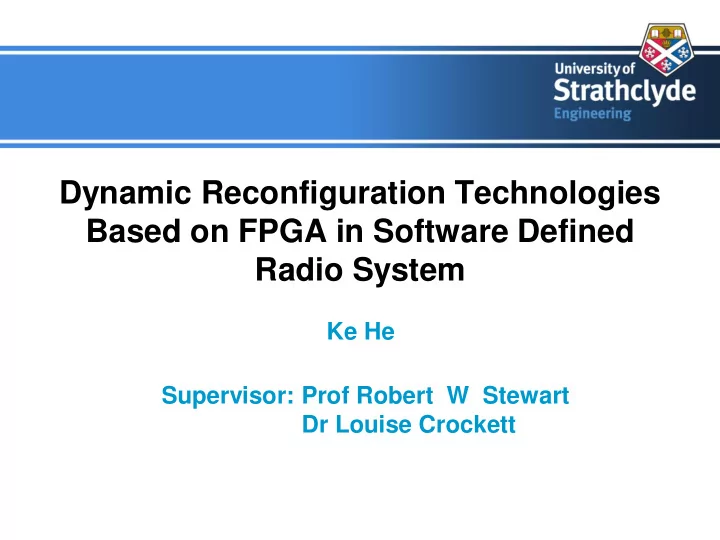

Dynamic Reconfiguration Technologies Based on FPGA in Software Defined Radio System Ke He Supervisor: Prof Robert W Stewart Dr Louise Crockett
Outline Motivation and Objective Reconfiguration Technologies : Dynamic Reconfigurable Ports and Partial Reconfiguration. Multiple Standards Analysis : Modulation and Digital Front End parts of LTE, WiMAX and WCDMA standards Hierarchical Design Methodology Results and Comparisons Conclusion
Motivation Software Defined Radio can accommodate various standards and services Partial Reconfiguration is a promising technology which could increase hardware reuseability therefore reduce hardware cost and has commonalities with SDR For some cases, PR can work with Dynamic Reconfigurable Ports (DRP) technology which could lead to a less complex and lower cost SDR architecture . Objective Implement the key components e.g. Modulation and Digital Front End with PR to support multiple communication standards such as WCDMA WiMAX and 3GPP LTE Integrate these components into a single FPGA device with PR and DRP technologies to build a SDR system with less complex and lower cost architecture, while maintaining a high degree of design and function switching flexibility.
Partial Reconfiguration Technology The Partial Reconfiguration is such a technology that allows multiple design modules to time-share physical resources. Reconfigurable modules can be swapped on the fly and other parts the remain operation Advantages: Increase hardware reuseability Reduce hardware size and cost Limitation: The clock frequency could not be reconfigured by PR as the Digital Clock Manager (DCM) are not allowed to place in the reconfigurable logic
Dynamic Reconfigurable Ports Technology Digital Clock Managers (DCMs) : A hardware resource on FPGA to deal with the clock managements Eliminate clock skew Shift phase Synthesize a desired clock frequency Clock Clock Source Frequency DCM IBUFG
Dynamic Reconfigurable Ports Technology State Machine Control DCM_ADV DRP_DADDR DADDR DRP_EN DEN Start DRP_Start CLKFX DWE DRP_WE Clock inpu t Clock DRP_DRDY DRDY Reset DCM_RESET RST LOCKED ….. Multiplier [7:0] DI [15:0] Divisor [7:0] Concatenate FPGA
Multiple Communication Standards Analysis Modulation Analysis OFDM OVSF Standards Mapper FFT Size CP Length Spreading Factor 80,72 and 40,36 LTE 5/10 MHz QPSK 16QAM 64 QAM 512, 1024 None samples 1/4, 1/8, 1/16, WiMAX 3.5/5/7/10 MHz QPSK 16QAM 64 QAM 512, 1024 1/32 of frame None duration 4,8, 16,32, 64, 128, WCDMA QPSK None None 256, 512 Digital Front End Analysis I I Multiplier Channel Filter Interpolation Baseband DDS IF Q Q Channel Filter Interpolation Multiplier
Multiple Communication Standards Analysis Design Bandwidth Input Sample Rate (Msps) IF (MHz) System Clock (MHz) LTE 5 MHz 7.68 61.44 245.76 LTE 10 MHz 15.36 61.44 245.76 WCDMA 3.84 61.44 245.76 WiMAX 3.5 MHz 4 64 256 WiMAX 5 MHz 5.6 44.8 179.2 WiMAX 7 MHz 8 64 256 WiMAX 10 MHz 11.2 44.8 179.2 Note: Three standards and 7 modes System Clock of 4 times of the IF Sample Rate Three different clock frequencies are required: 245.76 MHz, 256 MHz and 179.2 MHz
Combination of dynamic reconfiguration technologies Waveforms switching means not only changing functions but also changing the clock frequency of the function PR is insufficient to implement all of the switching functions in isolation The DCM with DRP architecture is able to control for the Reconfigurable Partition DRP Clock DUC RP Oscillator DCM FPGA
Hierarchical Design Methodology Advantages: Top FPGA Device Level PR benefits High integration on a Static Static Static DRP DRP DRP DCM DCM DCM single FPGA Layer 1 Reconfigurable clock Error DUC Modulation Coding RP frequencies RP RP High degree of flexibility Mapper Transform RP RP Easy to maintain and Layer 2 QPSK IFFT update 16 QAM Spreader 64 QAM Modulation RP
Hierarchical Design Methodology 245.76 MHz 256 MHz 179.2 MHz Clk_256 DUC I DCM DUC RMs CLK Divider RP Clka LTE 1/16 1/32 1/64 Clk_50 WiMAX Clkb Mapper WCDMA Q DCM Mapper Clk_100 100 MHz Transform RP 200 MHz QPSK 16 RP 300 MHz DUC RP RAM QAM 64 IFFT Spreader Data_in QAM Modulation RP
Results: Post-Placed and Route Simulation
Hardware Resource Utilization Results Table 1: Without PR Table 2: With PR & DRP LUTs FFs Slices DSP4 LUTs FFs Slices DSP4 RP 8Es RAMs RP 8Es RAMs (MHz) (MHz) LTE 5 1504 2148 799 11 9 424.1 LTE 5 1533 2005 543 11 9 336.2 LTE 10 1438 2004 872 14 9 355.6 LTE 10 1455 1873 557 14 9 374.2 WCDMA 1493 2020 722 8 9 419.1 WCDMA 1532 1899 533 8 9 273.8 WiMAX WiMAX 1629 2223 869 14 9 386 1663 2079 582 14 9 280.0 DUC 3.5 3.5 DUC WiMAX WiMAX 5 1474 2083 817 14 9 390.9 1497 1964 554 14 9 269.3 5 WiMAX WiMAX 7 1540 2194 878 17 9 312 1565 2084 612 17 9 354.1 7 WiMAX WiMAX 1449 2130 842 20 9 295.3 1466 2014 604 20 9 374.0 10 10 OFDM 3430 3570 1405 12 5 286.9 OFDM 3442 3559 1193 12 5 275.6 Transform Transform Spreader 34 9 11 0 0 375.7 Spreader 45 9 12 0 0 188.0
Fix function FPGA Design to support multi-standards LTE 10 IFFT Selector WiMAX 7 Clk_256 WiMAX 10 Clk_245.76 Clk_179.2 Clk_100 Spreader WCDMA FPGA Slices DSP48Es RAMs 4657 71 41
PR & DRP Design Architecture Spreader IFFT LTE WCDMA WiMAX Transform RP DUC RP Clk_256 FPGA Clk_100 Resource = max (transform(RP)) + max(DUC(RP)) Slices DSP48Es RAMs 1805 32 14
Results and Comparison Slices DSP48Es RAMs Reduction 61.24% 54.93% 65.85%
Dynamic Reconfiguration WCDMA 64 QAM DUC Mapper WiMAX DCM DCM Spreader 16 QAM LTE QPSK IFFT Transform RP Mapper RP DUC RP Modulation RP FPGA Partial Bitstream QPSK LTE Library 16 QAM IFFT WiMAX 64 QAM Spreader WCDMA
Conclusion Support Baseband and IF processing components Support multiple standards and modes High degree of design and function switching flexibility Reduction of 61.24%, 54.93% and 65.85% in respect of Slices, DSP48Es and RAMs Reduction of two oscillator inputs
Recommend
More recommend